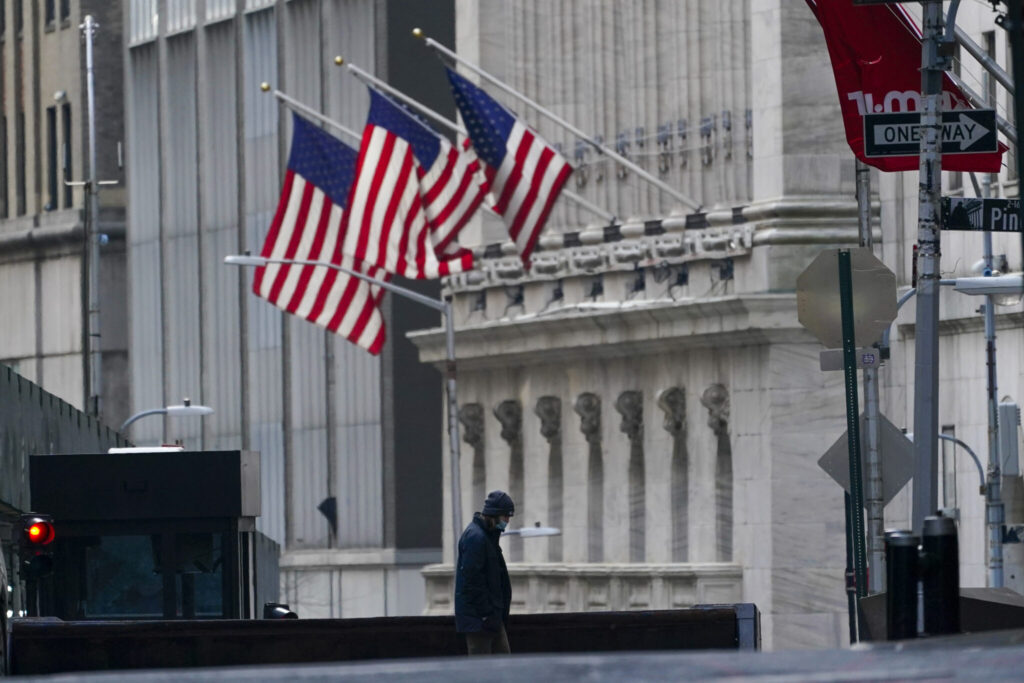Wall Street’s main indexes edged lower on Friday after data showed the economy added jobs at a rapid pace last month, feeding into fears that the Federal Reserve could keep interest rates higher for longer in its fight against inflation. The Labor Department’s nonfarm payrolls report showed 517,000 job additions in January, almost three times expectations of 185,000 additions. The unemployment rate ticked down 3.4% in January to hit a more than 53-1/2-year low. The Associated Press has the story:
Wall Street’s rally stalls on hot jobs, cold earnings
Newslooks- NEW YORK (AP)
Wall Street’s rally is stalling Friday after a stunning jobs report showed the U.S. economy created a third of a million more jobs last month than expected, fueling worries about inflation and higher interest rates.
The S&P 500 was 0.4% lower in morning trading after paring a bigger early loss. The Dow Jones Industrial Average was down 58 points, or 0.2%, at 33,995, as of 10:19 a.m. Eastern time, and the Nasdaq composite was 0.4% lower.
The market already looked like it was set to weaken before the jolting jobs report dropped. Late Thursday, several of Wall Street’s most influential companies reported weaker profit for the latest quarter than analysts expected.
That cast concerns over a rally that had brought the S&P 500 back to its highest level since August, driven mostly by hopes that cooling inflation may mean the Federal Reserve will soon take a pause on its hikes to interest rates and possibly even cut them by late this year.
Then came the jobs report, which showed employers created a net 517,000 jobs last month. That was way above the 185,000 that economists expected and a sharp acceleration from December’s 226,000 jobs.
Normally, a stronger jobs report is good for Wall Street because it means the economy is on firmer fitting. But in this upside-down post-COVID world, it can be a worrisome sign. The Fed is in the middle of trying to cool down the job market, in hopes of taking pressure off inflation.
The concern in the market is that the much stronger-than-expected hiring could keep the Fed on the “higher-for-longer” path on interest rates that it’s been talking about, even if markets haven’t been believing it fully.
“It’s going to get harder to argue that rate cuts may be in 2023’s future if the labor market is able to continue like this, especially considering that it remains to be seen how quickly inflation will fall, even if we have reached the peak,” said Mike Loewengart, head of model portfolio construction at Morgan Stanley Global Investment Office.
Treasury yields zoomed higher immediately after the jobs report on forecasts for a firmer Fed. The yield on the two-year Treasury, which tends to track expectations for the Fed, jumped to 4.25% from 4.10% late Thursday. The 10-year yield, which helps sets rates for mortgages and other important loans, rose to 3.52% from 3.40%.
The reaction wasn’t quite as forceful in the stock market, which opened with sharp losses and then pared them.
Some analysts said they were paying more attention to the data on wages in the jobs report than overall hiring, which wasn’t as surprising.
Average hourly earnings for workers were 4.4% higher in January than a year earlier. That’s a slowdown from December’s 4.8% raise, though it was a touch above expectations. While slower wage gains hurt workers trying to keep up with rising prices at the register, it also means less pressure on inflation.
“The Fed has been downplaying the importance of the unemployment rate and payrolls number, focusing more on wage gains instead,” said Brian Jacobsen, senior investment strategist at Allspring Global Investments. “Wage gains were in line with the consensus expectations, so I’m not as worried as most about the path ahead for the Fed.”
Also helping to muddy the picture was a report showing the U.S. services sector returned to growth in January. It was a much stronger reading than expected, though it also suggested pricing pressures may be easing.
Big Tech stocks were helping to lead the market lower following some weaker-than-expected earnings reports.
Amazon fell 5% and was one of the biggest weight on the S&P 500, while Google’s parent company dropped 1.7%. Because they’re among the most valuable stocks on Wall Street, their movements carry more weight on the S&P 500 than others.
On the winning side was Clorox, which jumped 6.3% after reporting much stronger profit for the end of 2022 than expected.







